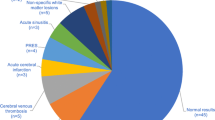Abstract
Background
Headache is one of the most common emergency department complaints with three million visits annually in the USA. This is further complicated with 30% of those emergency visits being for a hypertensive disorder of pregnancy. There is no currently well-established guideline for diagnostic imaging with a common concern being ionizing radiation exposure in pregnancy. The purpose of this study was to assess the difference in imaging studies ordered for pregnant and non-pregnant patients who reported to a tertiary care emergency department with headache.
Objective
The purpose of this study was to assess the difference in imaging studies ordered for pregnant and non-pregnant patients who reported to a tertiary care emergency department with headache.
Study design
This retrospective cohort study identified all reproductive age female patients who presented to the emergency department with a chief complaint of “headache.” They were then divided into cohorts based on pregnancy status. Rates and types of imaging studies utilized in patient evaluation were then compared.
Results
Two thousand seven hundred ninety patients met our criteria for evaluation; 95 were found to be pregnant. Head CTs were ordered significantly less and MRIs were ordered significantly more in the pregnant cohort as compared to the non-pregnant cohort with a P value of <0.0001 and an odds ratio of 4.21 and a P value of 0.0127 and an odds ratio of 0.49, respectively.
Conclusion
Our data shows a difference in evaluation for pregnant patients as compared to their non-pregnant cohort. CT should not be considered contraindicated in the pregnant population and the amount of ionizing radiation to the fetus is well within the maximum safe dose, particularly with appropriate shielding. The time difference, cost, fetal exposure risk, and availability of CT compared to MRI should be taken into account when establishing a criterion for diagnostic evaluation. This difference validates the need for further research into a well-established guideline for the emergent evaluation of headache in the ED without special bias placed on pregnancy status.
Similar content being viewed by others
References
Lucado J, Paez K, Elixhauser A (2006) Headaches in U.S. hospitals and emergency departments, 2008: statistical brief #111. Vol 24. http://www.ncbi.nlm.nih.gov/pubmed/21735579
MacGregor EA, Frith A, Ellis J, Aspinall L, Hackshaw A (2006) Prevention of menstrual attacks of migraine: a double-blind placebo-controlled crossover study. Neurology 67(12):2159–2163. doi:10.1212/01.wnl.0000249114.52802.55
MacGregor EA, Frith A, Ellis J, Aspinall L, Hackshaw A (2006) Incidence of migraine relative to menstrual cycle phases of rising and falling estrogen. Neurology 67(12):2154–2158. doi:10.1212/01.wnl.0000233888.18228.19
Zacur HA (2006) Hormonal changes throughout life in women. Headache 46(Suppl 2(s2)):S49–S54. doi:10.1111/j.1526-4610.2006.00554.x
Robbins MS, Farmakidis C, Dayal AK, Lipton RB (2015) Acute headache diagnosis in pregnant women. Neurology 85(12):1024–1030. doi:10.1212/WNL.0000000000001954
Macgregor EA (2014) Headache in pregnancy. Continuum (Minneap Minn) 20(1 Neurology of Pregnancy):128–147. doi:10.1212/01.CON.0000443841.40933.9e
Ramchandren S, Cross BJ, Liebeskind DS (2007) Emergent headaches during pregnancy: correlation between neurologic examination and neuroimaging. AJNR Am J Neuroradiol 28(6):1085–1087. doi:10.3174/ajnr.A0506
Brent RL (2009) Saving lives and changing family histories: appropriate counseling of pregnant women and men and women of reproductive age, concerning the risk of diagnostic radiation exposures during and before pregnancy. Am J Obstet Gynecol 200(1):4–24. doi:10.1016/j.ajog.2008.06.032
Ratnapalan S, Bentur Y, Koren G (2008) Doctor, will that x-ray harm my unborn child? CMAJ 179(12):1293–1296. doi:10.1503/cmaj.080247
Lazarus E, Debenedectis C, North D, Spencer PK, Mayo-Smith WW (2009) Utilization of imaging in pregnant patients: 10-year review of 5270 examinations in 3285 patients—1997-2006. Radiology 251(2):517–524. doi:10.1148/radiol.2512080736
ICRP (2007) ICRP 103: the 2007 recommendations of the International Commission on Radiological Protection. Ann ICRP 37:330. doi:10.1016/j.icrp.2007.10.001
Wrixon AD (2008) New ICRP recommendations. J Radiol Prot 28(2):161–168. doi:10.1088/0952-4746/28/2/R02
Tremblay E, Thérasse E, Thomassin-Naggara I, Trop I (2012) Quality initiatives: guidelines for use of medical imaging during pregnancy and lactation. Radiographics 32(3):897–911. doi:10.1148/rg.323115120
Wang PI, Chong ST, Kielar AZ et al (2012) Imaging of pregnant and lactating patients: part 1, evidence-based review and recommendations. AJR Am J Roentgenol 198(4):778–784. doi:10.2214/AJR.11.7405
Wang PI, Chong ST, Kielar AZ et al (2012) Imaging of pregnant and lactating patients: part 2, evidence-based review and recommendations. AJR Am J Roentgenol 198(4):785–792 http://www.ncbi.nlm.nih.gov/entrez/query.fcgi?cmd=Retrieve&db=pubmed&dopt=Abstract&list_uids=22451542
Guideline AP, Mark A Guenin, Alan S Brody, Louis K Wagner, Robert P Guillerman TC (2008) ACR practice guideline for imaging pregnant or potentially pregnant adolescents and women with ionizing radiation. Article 1076(Revised 2008):23–37.
ACOG (2011) ACOG practice bulletin: clinical management guidelines for obstetrician-gynecologists. Obstet Gynecol 118(2):372–382. doi:10.1097/AOG.0b013e31822c98e5
Douglas AC, Wippold FJ, Broderick DF et al (2014) ACR appropriateness criteria headache. J Am Coll Radiol 11(7):657–667. doi:10.1016/j.jacr.2014.03.024
McCollough CH, Schueler BA, Atwell TD et al (2007) Radiation exposure and pregnancy: when should we be concerned? Radiographics 27(4):908–909. doi:10.1148/rg.274065149
Tirada N, Dreizin D, Khati NJ, Akin EA, Zeman RK (2015) Imaging pregnant and lactating patients. Radiographics 35(6):1751–1765. doi:10.1148/rg.2015150031
Author information
Authors and Affiliations
Corresponding author
Ethics declarations
Conflict of interest
The authors declare that they have no conflict of interest.
Additional information
The lead author (Stephen Wagner) affirms that this manuscript is an honest, accurate, and transparent account of the study being reported; that no important aspects of the study have been omitted; and that any discrepancies from the study as planned (and, if relevant, registered) have been explained.
Rights and permissions
About this article
Cite this article
Waldman, I., Wagner, S., Posadas, K. et al. The impact of pregnancy on headache evaluation in the emergency department, a retrospective cohort study. Emerg Radiol 24, 505–508 (2017). https://doi.org/10.1007/s10140-017-1497-3
Received:
Accepted:
Published:
Issue Date:
DOI: https://doi.org/10.1007/s10140-017-1497-3




